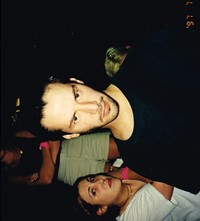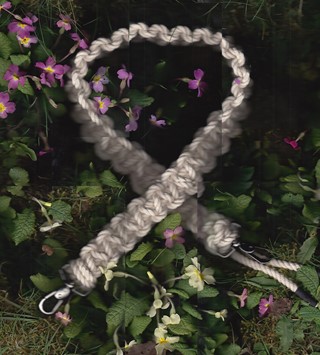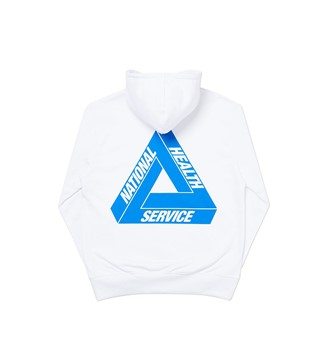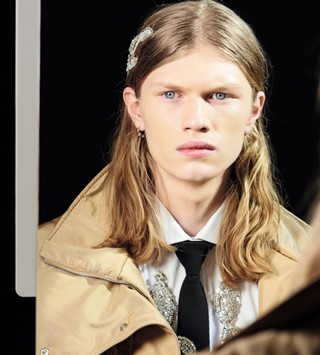As the actor celebrates his 55th birthday, we look at Keanu Reeves’ journey to becoming an unlikely style icon
- TextJack Moss
Recently, the journalist Naomi Fry wrote a piece for the New Yorker titled: “Keanu Reeves Is Too Good for This World”. In it, she documents the near-fervent level of fandom which surrounds the famously private star, who rose to fame as a doe-eyed, ‘far out’ teen in Bill and Ted’s Excellent Adventure and Point Break in the early 1990s. The intermingling of stories of his personal kindness, recounted and meme’d about on social media – helping to push Octavia Spencer’s car when it broke down in Los Angeles; giving up his seat for a woman on the subway; looking sad while eating a sandwich – combined with an indefinable, enigmatic movie-star otherness has resulted in a slew of new, younger fans: so much so, 2019 has been dubbed the ‘Keanunaissance’.
Peak ‘Keanunaissance’ might have been his appearance in Anthony Vaccarello’s Autumn/Winter 2019 menswear campaign for Saint Laurent, which prompted typically emphatic responses from the internet (“this is not a drill,” ran the headline on Dazed). In the black-and-white David Sims-shot photographs he stares outwards down the barrel of the camera, wearing a motorcycle leather jacket; in another, he tilts his head downwards in a pair of dark-lensed aviator sunglasses (comparisons with his The Matrix character Neo abounded). A few weeks later, he attended Saint Laurent’s Malibu menswear show and sat front row; the month before, he was American GQ’s cover star (headline: “The Legend of Keanu Reeves”). He was deemed 2019’s unlikely style icon.
But the truth is, he’s always been a sort-of style icon, wearing the type of uncomplicated ensembles which would be near-impossible to replicate if you actually tried (similarly, see: River Phoenix, or Kurt Cobain). There is a photograph of him as a teenager, taken in 1988, on the cusp of stardom: he peers out from a jumble of dark hair, sprawled on a velvet sofa in ripped jeans, a T-shirt and tennis shoes. A year later, he attends an event with Winona Ryder; she is in a delicate white cocktail gown, he, stained trousers and a T-shirt – both well-worn. In 1992, he is photographed walking down a Los Angeles street with Sofia Coppola – now, hair short – in a baggy suit and desert boots, holding a motorcycle helmet in his hand, as if ready for escape.

The clothes say he’s just like us – and yet, of course, he’s not. Reeves’ appeal teeters here: while he is by no means the typical beefed-up Hollywood heartthrob, he holds an appeal of an entirely different kind, one that’s not so easy to decipher. “There is an ambiguity about him. He’s not androgynous. He’s not alpha male. He’s masculine and feminine in a way,” William Irwin, a pop culture professor is quoted as saying in The New York Times. “He has his interests and pursuits, but he doesn’t have airs about him. He doesn’t pretend to be something he is not. He has a quest quality, searching.”
This riddle-like quality has been echoed in his most memorable roles: brooding, stuck-in-the-societal system hacker Thomas Anderson (aka Neo) in The Matrix, yearning teen hustler in My Own Private Idaho (played opposite Phoenix) or history class-flunking time-travelling Californian student in Bill and Ted’s Excellent Adventure. More recently, a comic turn, playing a parody of himself in comedian Ali Wong’s romantic-comedy Always Be My Maybe released this year on Netflix. In it, he shoots out pseudo-spiritual musings: “Do you have any dishes that play with time? The concept of time,” he asks a waiter.
But we’re in on the joke. The Reeves we know still wears Merrell hiking boots on the red carpet; and has a sub-reddit (/r/keanubeingawesome) devoted to his various acts of kindness – we know he’s never been that kind of movie star. Besides, behind the irony and insouciance is a far more tragic tale – “The Saddest Story You’ll Ever Read Is the Life of Keanu Reeves,” Trey Taylor posited in a recent piece for Another Man. “The misfortune that has befallen Reeves rivals the plot of any Greek tragedy,” Taylor writes of the various well-documented events which have tinged Reeves’ life: the abandonment by his father as a young child, the death of Phoenix, then of his ex-girlfriend Jennifer Symes, who was killed in a car crash after attending a party at Marilyn Manson’s house.
“He has resisted the ineffable suck of depression’s vacuum, fought off the twisted sickness of a lost will,” Taylor continues. “He continues to act and ride his motorcycle, likely looking nowhere but ahead. His life has been unusually sad. But sometimes awful things have their own kind of beauty.”
Reeves now lives in the Hollywood Hills, and has done so for the previous 12 years. Little more is known about how he spends his time, save for riding his prized Harley-Davidsons, of which he has a vast collection, through California’s Santa Monica mountains (the uniform: a leather jacket and jeans). Other pursuits are documented in the various paparazzi photographs, many of which end up being @keanudoingthings memes: “Keanu Reeves eating lunch & falling into a food coma”; “Keanu Reeves drinking a Corona and having an existential crisis”; “Keanu Reeves playing with puppies.” In these photographs his style has barely diverted from those things he wore when he first rose to fame: baggy T-shirts and cargo pants, the occasional roomily proportioned suit, baseball caps and ripped jeans. The only difference now is the beard, speckled with grey hairs.
To dwell too hard on Reeves’ clothing choices might well be to miss the point – one gets the sense that the actor spends little consideration on what he wears on a given day, and would be reluctant – and vaguely confused – at the idea of being deemed an icon of style. But maybe that is the point: while the next generation of Hollywood starlets look increasingly beset by the rigours of the movie industry, Reeves wears his fame with indelible ease. His appeal, then, is straightforward: he makes life look good. Great, even. So who wouldn’t want to dress like him?















